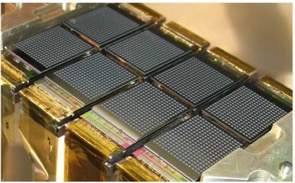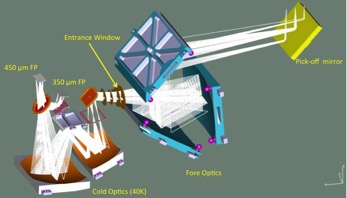Overview
ArTeMiS (Architectures de bolometres pour des Telescopes a grand champ de vue dans le domaine sub-Millimetrique au Sol) is an ESO PI project of a large bolometer camera in the submillimeter range (200, 350 and 450 μm) on APEX. CEA-Saclay and IAS in France and the University of Manchester are developing the instrument in collaboration with ESO. The instrument is based on the technology of bolometer arrays developed for the PACS camera on-board the Herschel Space Observatory but adapted to the high optical load encountered at APEX site.
These bolometers consist in Si:P:B bolometers arranged in 16×18 sub-arrays operating at 300mK. The final instrument will contain 2×8 sub-arrays at 350 and 450 μm (and potentially 2 sub-arrays at 200 μm). They were background limited in the Herschel/PACS instrument and should provide the same performances under ground-based conditions.

ArTeMiS 350 μm focal plane used for the 2014 run at APEX (Reveret et al. 2014)
3D representation of the ArTeMiS all-reflective optics (Reveret et al. 2014)

The bolometers do not use feed horns to concentrate the sub-millimeter light, but act more like a CCD camera. ArTeMiS can therefore instantaneously fully sample the image in the focal plane and does not require any “jiggling” pattern. The estimated gain in speed when mapping extended sources is about 3 compared to a classical bolometer array (for instance the APEX/SABOCA instrument at similar wavelengths) with feed horns with the same sensitivity and FOV.
.
Observing with ArTéMiS
The major observing modes available at APEX can be used with ArTéMiS. Spiral maps can be used for compact sources or to correct for pointing offsets on strong sources (planets, HII regions). For larger fields, rasters or spirals maps have been tested as well as the “On-The-Fly” mode for beam-maps or large maps.
To estimate integration times with ArTéMiS, visit our observing time estimator section, and look for the estimator for this instrument.
Calibration and data reduction
The opacity of the sky can be determined via skydip measurements.
The beam at 350 μm has been measured to be 8.5 arcsec., which is in good agreement with the beam of the 12m APEX dish.
The array parameter (RCP) file include the relative offsets of the individual channels as well as their relative gains. You can access the RCP file for ArTéMis here:
Data reduction
ArTéMiS data can be read with the BoA and CRUSH software packages but there is a specific pipeline designed by the instrument team. Find all the information our the page about data reduction of bolometer data.